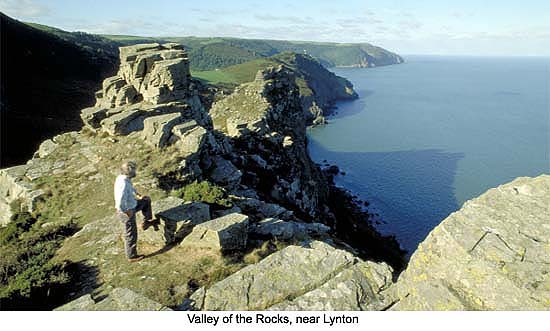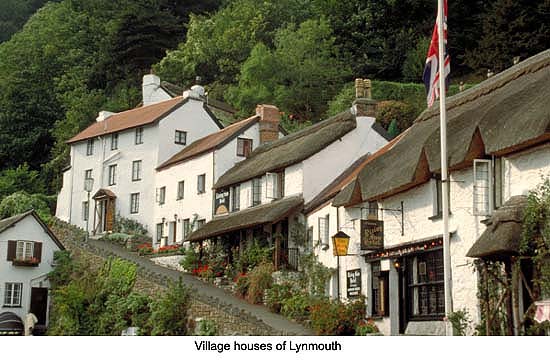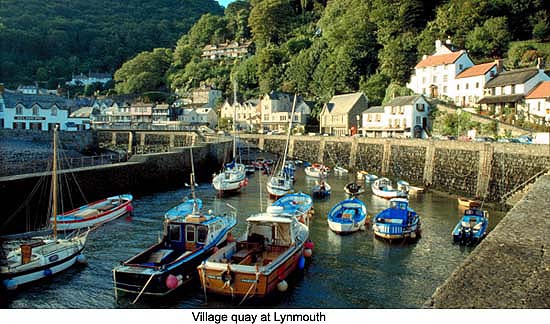Lynton and Lynmouth: The Twins of North Devon
by Christina Hamlett
Like fraternal twins separated at birth, Lynton and Lynmouth have
grown up on either side of the Exmoor headland's wooded cliffs,
their personalities shaped by the respective influence of society
and sea. Both comprised of thatched cottages and quaint shops
reminiscent of a child's storybook, Lynton is the more
aristocratic and leisurely of the two. Lynmouth, situated below
in a gorge carved by the confluence of two rivers, is an
unabashed fishermen's village, teeming with an energy little
changed from that of its ancestors over a century ago. The
combined population of these two villages has grown very little
as well, in spite of the attractive draw of their location,
climate and the surrounding natural beauty of Exmoor National
Park.

To really appreciate the appeal of the North Devon Coast,
however, one needs to understand that the region never
aggressively positioned itself as part of mainstream England and,
thus, failed to attract a rash of greedy nobles who not only
might have run things differently but might have attracted
enemies in the process. Its actual origins date back to the
Neolithic and Bronze Age, a backdrop that's easy to picture as
you wend your way along the rocky coastal trails. Prehistoric
artifacts, tools and fossils are not an uncommon sight in the
area's historical museums, as are the ruins and smattering of
henges left behind by Romans, Normans and Saxons. Geographically
undesirable in terms of a power base, it enjoyed the advantage of
being left alone while the rest of the world pretty much went on
without it. The common folk who migrated here during the
Dark Ages were primarily just trying to find warmer temperatures
to do their farming, including the modest harvesting of grapes
for wine. Distrustful of strangers coming in and upsetting their
copasetic status quo, the impression they projected was that
those who planned to take up residence might not necessarily be
welcomed with open arms. As insular a community as they tried to
maintain, however, it was no protection against the spread of
plague, the decline of a woefully limited economy and the
pernicious tricks of Mother Nature. A succession of brutal
winters, droughts and even an earthquake in nearby Barnstaple in
the late 1600's left many starting to think that maybe shooing
away the tourists hadn't been such a good idea, especially in the
unbidden absence of healthy, able-bodied locals to do the
work.

It was the advent of the Napoleonic Wars that finally inspired
them to warm up to the idea of tourism as a way to generate the
much needed capital to keep their villages humming. Fearful of
traveling to Europe and yet anxious to slip away from some needed
R&R, English travelers on holiday made the discovery that
northern Devon had all the charm and amenities of the continent
but was secluded enough to sidestep any physical danger. To the
surprise of the locals, Lynton and Lynmouth quickly became a
retreat for painters, musicians, poets and writers seeking a
tranquil setting to exercise one's muse. With the arrival of
luminaries such as Samuel Coleridge, William Wordsworth and Percy
Shelley, it soon grew apparent that more inns and eateries were
needed to accommodate the favorable word of mouth publicity being
spread. So competitive was the inn trade that telescopes and
runners were put to use in order to claim dibs on the latest
arrivals, a humorous scenario that conjures the more modern image
of what happens when a prospective buyer steps onto the lot of a
car dealership.
Nicknamed "Little Switzerland," the villages retained
their popularity as a sequestered resort through the Victorian
era, an influence reflected in the number of tea rooms, vintage
hotel furnishings, and museums that feature memorabilia and
photos from the turn of the century. Visitors can also marvel at
the water-powered Cliff Railway installed in the 1890's to
facilitate easy travel between the two towns.
Our own discovery of Lynton and Lynmouth was purely the product
of accident. Literally. A multi-car collision on the A-39 west
of Minehead threatened a delay that put us at the vexing midpoint
of being too far away from our intended destination as well as
too far just to turn around and return home. Although we had
packed for an overnight stay, the impending approach of sundown
and our lack of a reservation also meant that we might be
deprived of a room for the night. Given that two out of three of
us consider "roughing it" the condition of not being
able to plug in a blow dryer and a curling iron, we outvoted our
male companion and insisted on taking the next available
turn-off.
Our spontaneity was rewarded not only with a modestly priced inn
(plus full breakfast) on the main street of Lynmouth but
enthusiastic recommendations for dining and sightseeing as well.
We also had the luck of arriving before the Memorial Hall had
closed its doors for the day, providing us with a harsh look at
how the forces of Mother Nature nearly erased all evidence of
Lynmouth's existence from the map.
The exhibition hall, built to commemorate those who lost their
lives, features a gallery of photographs and artifacts from a
violent summer storm and flood in 1952 that sent over a hundred
thousand tons of water, boulders, mud and debris crashing through
the village streets. The combined forces of the East and West
Lyn Rivers were enough to topple houses and shops in their path,
uproot entire groves of trees, and smash every fishing boat that
was moored in the harbor. Repair of the destruction and the
implementation of measures to ensure it would never happen again
took nearly four years to complete. Such tragedies, of course,
are never without the emergence of unsung heroes and the exhibit
is generous in its praise of those who opened their hearts, their
homes and their wallets in the aftermath of the flood's
devastating effects.

Acts of bravery, however, are no stranger to the seafaring
residents of Lynmouth. In 1899, a cargo ship called The Forrest
Hall was caught in a storm in the Bristol Channel off the Devon
coast. When it became apparent that the conditions were too
dangerous to try to undertake a rescue effort from Lynmouth
harbor, a group of 20 men and team of 18 horses proceeded to drag
a 3-ton lifeboat a distance of 14 miles (all hilly and in the
dark) where it could be safely launched from another port. Even
more remarkable than the fact that The Forrest Hall and all of
her crew were saved is that this nighttime endeavor lacked the
modern advantages of ship-to-shore communications. Sans any
contact with The Forrest Hall for a period of over 15 hours, the
Lynmouth volunteers had no idea if the battered ship would even
be within sight by the time they reached the docks at Porlock
early the following morning.
The nautical themes of the region are repeated in abundance in
houses and inns that once knew the likes of sea captains and
smugglers. At Watersmeet House, a Lynmouth fishing lodge dating
from the 1830's, visitors can enjoy exhibits and a spot of tea.
Now operated by the National Trust, Watersmeet is open daily from
April to October during the hours of 10:30 and 4:30.
Save time as well for a tour of Town Hall. Its design,
construction and ornamentation were financed by Sir George
Newnes, a wealthy entrepreneur whose credits in publishing
included the adventures of Sherlock Holmes and whose enthusiasm
as a visionary of better transportation between the twin villages
prompted the installation of the aforementioned Cliff Railway.
By the way, if your holiday happens to fall on the first Saturday
of the month, you won't want to miss the farmers market and
crafts fair which opens at 10 sharp at Town Hall. This can then
be followed by a brisk hike up to Hollerday Hill. Newnes was so
fond of his adopted villages that he built himself a manor house
up here with an enviable view. Although the estate was lost to a
fire almost a hundred years ago, the woods and trails now
occupying the site not only provide great exercise but panoramic
photo shoots, too, including a view of the coast of Wales across
the channel.
Another must-see while you're in the area is the Lyn and Exmoor
Museum on Market Street in Lynton. In addition to its collection
of Stone Age relics, this vintage building houses an extensive
display of farm tools and seafaring equipment from the past two
centuries and a Victorian dollhouse that will make you wish you
could shrink yourself down to fit through the doorway.

For outdoor enthusiasts, of course, Exmoor has more than just
cliffside hiking to commend it. Sport fishing and boating have
become popular draws, as are bicycling, horseback riding, and
even lessons in the Medieval art of falconry.
Are there any train-lovers in your group? One of Sir Newnes'
other bold ventures was to establish a railroad system in 1898
that would link Lynton with Barnstaple. Although it didn't
succeed quite to financial expectations during his lifetime and
subsequently became defunct, there was still sufficient regional
interest to keep Newnes' notion rolling until the 21st century.
Passenger trains are once more running between the two towns
during the hours of 11 and 4, offering a leisurely venue in which
to view the Exmoor countryside. Make sure you acquire a copy of
the timetable first, though, as its service tends to be erratic
during the non-summer months.
Speaking of Barnstaple, its proximity to Lynton and Lynmouth
makes it a value added stop on your English vacation. Situated
on the River Taw, Barnstaple's Saxon origins date back to 930
A.D. where its highest and best use at the time was as the first
line of defense against marauding Danes. It also has the
distinction of being the oldest borough in Great Britain, an
honor that still gets frequent mention amongst its contemporary
citizenry in taverns and shops.
Never a town to back down from a grand adventure (or a good
fight), local lore has it that Barnstaple ships were quick to
join the fray against the Spanish Armada in 1588 as well as
outfit merchants who were in search of fortune in that "New
World" everyone was talking about. Its emergence as a
lively center of trade and commercial activity is still seen
today in its eclectic assemblage of shops, farmers markets, art
galleries and museums. Barnstaple also offers a self-guided
historical tour that immediately reminded all three of us of
Boston's Freedom Trail back home. Named the Heritage Trail, this
walking tour covers 16 landmarks pertinent to the town's history
and development. In addition, the town's Heritage Center located
on Queen Anne's Walk is a multi-media exhibition hall that offers
something of interest for any age group.
Time permitting, you're not that far from the town of Arlington
and a must-see tour of the Arlington Court Estate. This Regency
era manor house and surrounding gardens was a private residence
until almost 1950. While romantics will enjoy an authentic
carriage ride around the grounds, younger members of the family
will squeal their heads off at something one wouldn't expect to
find at so elegant an address. Let's just say that the former
owner didn't keep bats in her belfry; they found a much more
hospitable environment down in the basement.
More Information:
We regret that we no longer have the resources to maintain up-to-date links and/or hours and pricing details for the various sites and attractions listed on this website. For more information about the location(s) listed above, please use your favorite search engine or visit Wikipedia.
Former actress and director Christina Hamlett is an award-winning author, instructor and script coverage consultant for the independent film industry. Her credits to date include 21 books, 115 plays and musicals, 4 optioned feature films, and columns that appear throughout the world. She and her husband reside in Pasadena, California.
Article © 2006 Christina Hamlett
Photos courtesy of Britainonview.com
|
